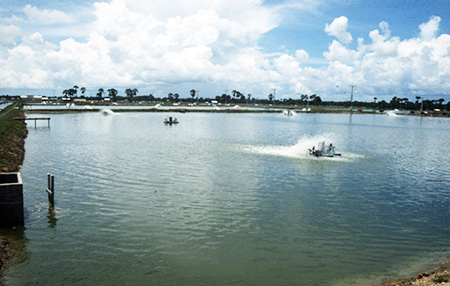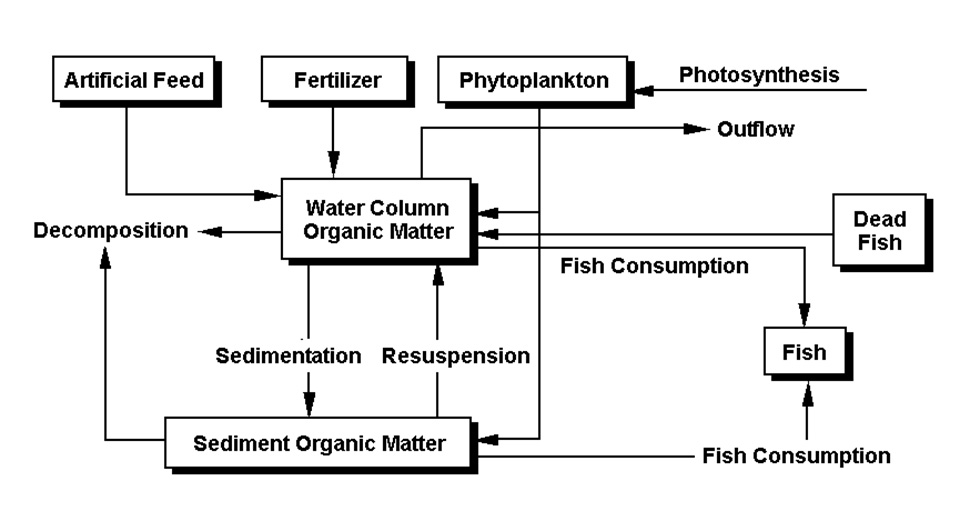Mechanistic simulation model developed to predict accumulation

Most aquaculture fish production comes from earthen ponds where artificial feeding and/or fertilization are used to provide feed for fish growth. Fertilization with animal manures and inorganic fertilizers – coupled with the application of supplemental feeds – is common in tilapia ponds in the developing world. More intensive pond and cage aquaculture, practiced in both industrialized and developing countries, is characterized by high stocking densities and the use of mechanical aeration and complete feeds that provide all the nutrients necessary for fish growth.
It has been estimated that about 60 percent of the nutrient and organic matter inputs to aquaculture ponds ends up in the pond bottoms. This material, coupled with silt that comes into the ponds with influent water, results in the accumulation of pond sediments. Often removed during pond maintenance, these sediments can be used to fertilize agricultural crops.
Forecasting the impact of different input and stocking strategies on sediment and organic matter accumulation is important for successful pond culture of fish under intensive conditions. Given the complexity of the biological and physical processes affecting sediments and water quality (Fig. 1), computer simulation models have become a helpful tool in the analysis of pond performance.

Sedimentation model
The authors developed a mechanistic simulation model to predict the accumulation of organic matter in pond bottoms and examine the effects of different input and stocking scenarios on accumulation and eventual fish yields. A component of a larger integrated aquaculture-agriculture system model, this model incorporates the sources and sinks of organic matter to the sediment.
New approach
Previous attempts to model organic matter sediment dynamics considered organic matter as a single entity. However, organic matter represents an assemblage of components. For example, fish feed contains cellulose, fats, lipids, proteins and carbohydrates, while organic manures commonly used in developing countries may also contain lignin. In addition, the humification of organic matter results in recalcitrant, stable organic matter.
The components of organic matter decompose and accumulate at different rates. But once buried in the anoxic layer of a pond bottom, decomposition rates decrease. By not recognizing the above factors, erroneous forecasting of accumulation rates and subsequent incorrect sediment and input management strategies can occur.
Therefore, a model that followed the decomposition of each of the major groups of pond inputs (stable organic matter, lignin, cellulose, and carbohydrates and proteins) and simulated the burial of organic matter within the sediment was developed. The major organic matter groups used in the model and their reactivities (per day) were carbohydrates and proteins (0.8), cellulose (0.05), lignin (0.0095), and stable organic matter (8.3 x 10-5).
Decomposition rates
Decomposition of each organic matter component depends on its concentration. However, each component has a different reactivity, with carbohydrates and proteins the most decomposable, followed by cellulose, lignin, and stable organic matter.
Decomposition occurs primarily in the aerobic top 1 mm of pond bottoms, and also in an anaerobic layer below. Decomposition rates are lower in the anaerobic layer than in the aerobic layer. Mass balance calculations that incorporated the major organic matter sinks and sources were made for each of the components.
Model verification
Model performance was evaluated by comparing the model output to organic matter sediment values obtained from new tilapia ponds where four inputs with varied reactivities were applied for six months. The model outcomes followed the trend of organic matter accumulation with values similar to the observed amounts.
10-year projection
We then applied the model to simulate 10-year organic matter concentrations in tilapia ponds to test whether steady-state conditions could be achieved within a five-year period. The model showed that a steady state could not be achieved within the time horizon when pond inputs were maintained at a constant level from crop to crop.
The implications of the results are that if pond sediments are not removed periodically, accumulated organic matter could affect pond health (and therefore fish production) through the promotion of low-oxygen conditions and toxic substances.
Under such circumstances, pond managers would be faced with various management options to improve culture conditions, such as increasing organic matter decomposition through mechanical aeration or underwater plowing of bottom soils, removal of fresh organic matter during the production season, or reducing stocking densities and input rates. In our model, these management options could be evaluated using the sensitivity feature in the user interface.
Conclusion
With increasing intensification of pond aquaculture, management of sediment organic matter sediment is becoming an important concern for pond managers. The model developed here should provide a useful forecasting and management tool for pond managers who wish to optimize their production by reducing the potentially deleterious effects of organic matter sediment on fish yields.
Although not included here, another important factor that is important to pond managers is the accumulation of silt in ponds. The factoring of silt inflow and accumulation in the sediment would increase the applicability of the model to a wider range of aquaculture pond systems.
(Editor’s Note: This article was originally published in the February 2002 print edition of the Global Aquaculture Advocate.)
Now that you've finished reading the article ...
… we hope you’ll consider supporting our mission to document the evolution of the global aquaculture industry and share our vast network of contributors’ expansive knowledge every week.
By becoming a Global Seafood Alliance member, you’re ensuring that all of the pre-competitive work we do through member benefits, resources and events can continue. Individual membership costs just $50 a year. GSA individual and corporate members receive complimentary access to a series of GOAL virtual events beginning in April. Join now.
Not a GSA member? Join us.
Authors
-
-
Raul Piedrahita, Ph.D.
Department of Biological and Agricultural Engineering
University of California
Davis, California, USA
Tagged With
Related Posts

Responsibility
Advancing shrimp farm technologies support greater efficiencies, sustainability
Todays' shrimp farm technologies include biosecurity protocols, stocking densities according to pond design and aeration levels, and best practices for pond preparation and feed and water management.

Aquafeeds
Aquaculture feed composition helps define potential for water pollution
A study found that feed for salmon and trout had higher organic carbon concentrations than did catfish, shrimp and tilapia feeds. Nitrogen and phosphorus concentrations were similar among salmon, trout and shrimp feeds, and higher than those in catfish and tilapia feeds.

Responsibility
Aquaculture ponds hold carbon
Although 16.6 million metric tons of carbon are annually buried in aquaculture ponds, estimated carbon emissions for culture species have approached several metric tons of carbon per metric ton of aquaculture product.

Health & Welfare
Bacillus probiotics improve hatchery, nursery production in EMS-hit Mexico
In early 2014, a trial to evaluate the effects of a mixture of Bacillus strains on early mortality syndrome bacteria during the larviculture and nursery phases for shrimp was carried out at a commercial hatchery in Mexico.


